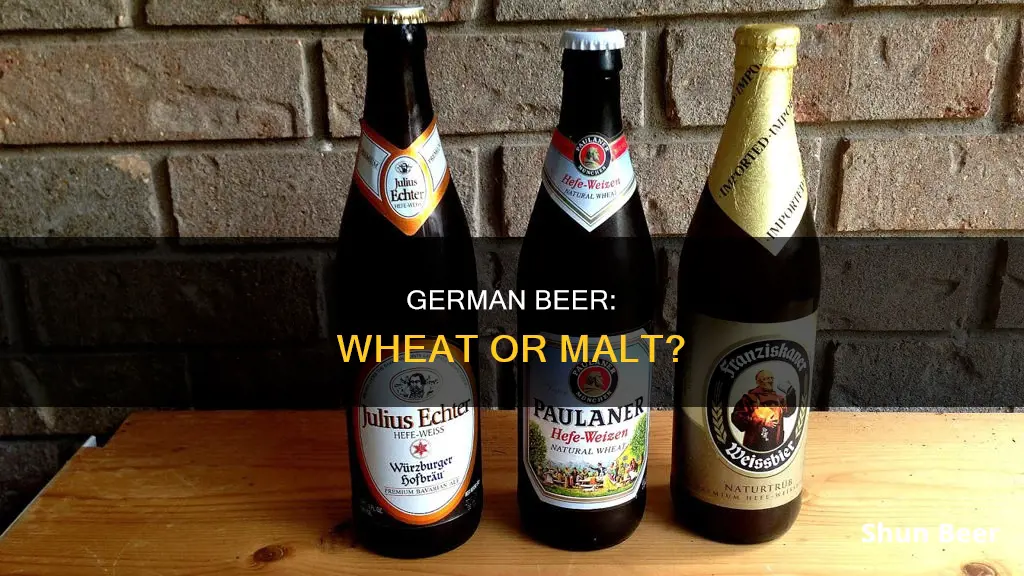
Wheat beer and malt beer are two of the most popular styles of German beer. Wheat beer, also known as Weizenbier or Weißbier, is a top-fermented beer brewed with a large proportion of wheat relative to malted barley. German law requires that wheat beer must contain at least 50% wheat malt, with the proportion of wheat sometimes reaching as high as 70%. Malt beer, on the other hand, is typically made with malted barley as the primary ingredient. German beers are known for their quality and tradition, and wheat and malt beers are no exception. Both styles have their own unique characteristics and are widely enjoyed, not just in Germany but also worldwide.
| Characteristics | Values |
|---|---|
| German wheat beer | Weizenbier, Weißbier, Berliner Weisse, Gose, Hefeweizen, Kristallweizen, Dunkelweizen, Weizenbock |
| Minimum wheat content | 50% |
| Maximum wheat content | 70% |
| Typical wheat content | 70:30 wheat to barley |
| Flavour | Banana, clove, bubble gum, vanilla, caramel, dark fruit, bready |
| Appearance | Cloudy, light-coloured, pale, golden, reddish, dark |
| Texture | Delicate |
| ABV | 2.5% to 14% |
What You'll Learn

German wheat beers require a minimum of 50% wheat malt
Wheat beers, or Weizenbier/Weissbier in German, are a major part of German culture. They are brewed with a large proportion of wheat relative to the amount of malted barley. German wheat beers require a minimum of 50% wheat malt in the mash, with the norm being somewhere between 50% and 70%. This is in contrast to wheat beers from the UK and North America, which may contain slightly less wheat malt.
The higher percentage of wheat malt in German wheat beers gives them their delicacy of texture and imparts a lighter body than barley malt, making them suitable for pairing with light dishes and seafood. Wheat malt also contributes to the distinctive fluffy mouthfeel of German wheat beers, as well as enhancing foam stability and increasing the beer's mouthfeel.
The first true wheat beer brewery was built in the Bavarian region of Germany as far back as the 15th century. For centuries, wheat beer remained under the control of the Bavarian royal family, who held the exclusive right to brew wheat beers. It wasn't until 1872, when pilsners became more popular, that wheat beer was released from royal control.
Today, almost a quarter of all beer sold in Germany is wheat beer, and it has also become incredibly popular outside of Continental Europe. German wheat beers are known for their distinctive banana and clove flavours, which are due to the special type of yeast used in brewing rather than the use of wheat malts.
Explore the Unique, Fruity World of Ales Wheat Beers
You may want to see also

German Weizenbier and Belgian Witbier are termed white beers
Wheat beer is a top-fermented beer brewed with a large proportion of wheat relative to the amount of malted barley. The two main varieties are German Weizenbier and Belgian Witbier.
German Weizenbier
Weizenbier, or Hefeweizen, is the standard German name for wheat beer. Weizen is German for "wheat", and "weiß" is German for "white". It is a beer, traditionally from Bavaria, in which a significant proportion of malted barley is replaced with malted wheat. Wheat beer was introduced in Bavaria in the 15th century. By law, Weizenbiers brewed in Germany must use a top-fermenting yeast. Specialized strains of yeast are used, which produce overtones of banana and clove as by-products of fermentation. The Hefeweizen style is particularly noted for its low hop bitterness and relatively high carbonation.
Belgian Witbier
Witbier, or simply Wit, is a Dutch-language name for the Belgian style of wheat beer. Wit means "white" in Dutch/Flemish. It is a barley/wheat, top-fermented beer brewed mainly in Belgium and the Netherlands. It gets its name from the suspended yeast and wheat proteins, which cause the beer to look hazy, or white, when cold. Along with hops, it usually contains a blend of spices, such as coriander, orange, and bitter orange.
German Weizenbier and Belgian Witbier are termed "white beers"
German Weißbier and Belgian Witbier are termed "white beers" because "wheat" has the same etymological root as "white" in most West Germanic languages, including English.
Crafting Wheat Beer: Adding Unique Flavors to Your Brew
You may want to see also

Wheat beers are ideal for hot weather
Wheat beers also have a higher carbonation level, which can be refreshing in hot weather. The higher protein content of wheat malt contributes to a generous stand of foam, enhancing the beer's refreshing quality. Furthermore, wheat beers are often served between 40 and 45 degrees Fahrenheit, which is warmer than most other beers. This temperature range allows the complex flavours and aromas of wheat beer to shine, providing a more interesting drinking experience.
Wheat beers are also versatile and can be crafted into a variety of styles, including German Weizenbier, Belgian Witbier, Lambic, Berliner Weisse, and Gose. This diversity means there is a wheat beer to suit a range of tastes and preferences, making them a popular choice for hot weather when a refreshing beverage is often desired. The lighter and more effervescent qualities of wheat beer can be particularly appealing when looking for a drink to cool down with.
Wheat beers have a long history, especially in Germany, where they hold cultural significance. The Bavarian royal family once held the exclusive right to brew wheat beers, only relinquishing this privilege in 1872. Today, wheat beers are enjoyed worldwide, and their consumption tends to soar in hot weather, making them a go-to choice for many beer enthusiasts during the warmer months.
Exploring the World of Wheat Beers: Are All Brews Wheat-Based?
You may want to see also

German wheat beers are known for their banana and clove-like flavours
German wheat beers, or weissbiers, are known for their fruity banana and spicy clove-like flavours. This unique flavour profile is created by the use of distinctive wheat malt and yeast. The banana flavour comes from the yeast, while the clove notes are produced by the wheat and how it's mashed.
The banana and clove flavours in German wheat beers are the result of the fermentation process and the specific strains of yeast used. The yeast used in weissbiers produces large amounts of chemical compounds known as phenols, which contribute to the banana and clove flavours. The intensity of these flavours can vary depending on the brewer, but they are typically well-balanced.
The fermentation temperature also plays a crucial role in developing these flavours. Brewing at warmer temperatures, around 70 degrees Fahrenheit or higher, enhances the banana flavours, while cooler temperatures tend to yield more clove notes. Additionally, open fermentation or good aeration can increase these flavour qualities.
The special yeast used in German wheat beers not only contributes to the unique flavour profile but also gives the beer its characteristic cloudy appearance. This is because the yeast remains in suspension in the beer, creating a cloudy look that is quite different from the clearer appearance of most beers.
The combination of banana and clove flavours in German wheat beers creates a complex and intriguing taste experience that has gained a dedicated following. These beers pair well with a variety of lighter foods, such as salads, seafood, and egg dishes, making them a versatile choice for many occasions.
Wheat Beers: Malt-Forward Brews Explained
You may want to see also

German wheat beers are brewed with a 70:30 wheat to barley ratio
Wheat beer is a top-fermented beer brewed with a large proportion of wheat relative to the amount of malted barley. German wheat beers, or hefe-weizens, are brewed with a classic ratio of 70:30 wheat to barley. This ratio is typical of the Munich-style hefe-weizen, though the proportion of wheat can be as low as 50%.
German wheat beers are characterised by their use of a ""top-fermenting" yeast, which produces overtones of banana and clove as by-products of fermentation. This gives German wheat beers their delicate texture and unique aroma. The banana and clove-like flavours are not, as is commonly thought, the result of the use of wheat malts, but rather the special type of yeast used.
The wheat malt used in German wheat beers is typically red (winter) wheat, though white wheat malt can also be used. The wheat is kilned to a similar Lovibond rating as white wheat malts, usually between 1.8 and 2.3 °L. Wheat malt contains more protein than barley malt, which can create lautering problems in the brewhouse. However, these issues can be managed by milling the wheat separately and performing a mash out to lower the viscosity of the wort.
The classic grist for a wheat beer is wheat malt and pale barley malt, typically Pilsner. The addition of a small amount of darkly roasted malts, such as chocolate or black malt, can be used to tweak the colour of the beer. German wheat beers are known for their low hop bitterness, high carbonation, and relatively high alcohol content.
Exploring Bock and Wheat Beer Differences
You may want to see also
Frequently asked questions
Wheat beer, also known as Weizenbier or Weißbier, is a top-fermented beer brewed with a large proportion of wheat relative to the amount of malted barley.
Wheat beer is brewed primarily with wheat, whereas malt beer is brewed with malted barley. Wheat beers tend to have a lighter body and a gently refreshing touch of acidity.
The two main varieties are Weizenbier and Belgian Witbier. Other types include Berliner Weisse, Gose, and Lambic.
German wheat beers are required by law to contain at least 50% wheat malt, with some varieties containing up to 70%.
German wheat beers are known for their delicate texture and citrus notes. They often have a cloudy appearance and a powerful banana and clove-like aroma due to the use of a special type of yeast.







